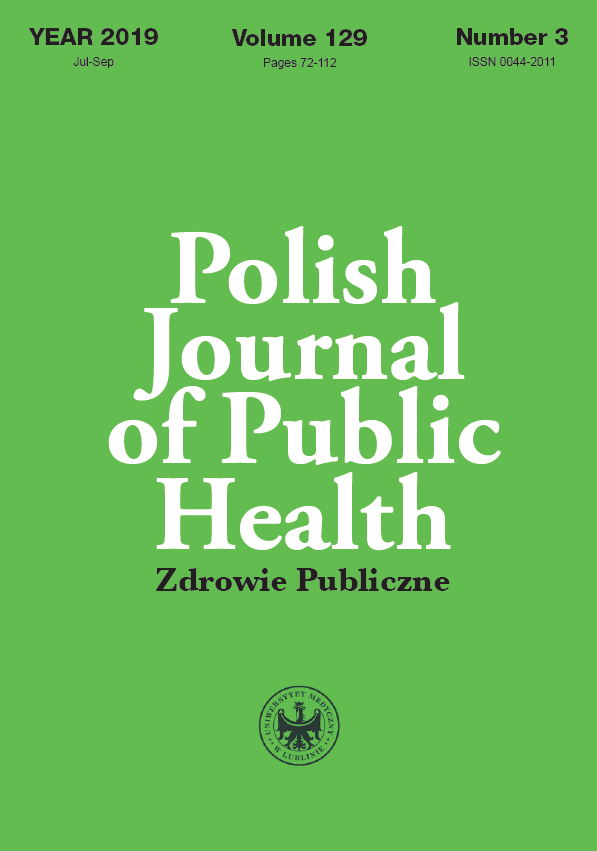The level of the illness acceptance among patients of the Department of Alcohol Addiction Therapy
DOI:
https://doi.org/10.2478/pjph-2019-0020Słowa kluczowe:
illness acceptance, alcohol dependence, self-esteem, self-effectivenessAbstrakt
Introduction. The illness acceptance is one of the most effective strategies to cope with a chronic illness.
Aim. The purpose of this study is to recognize which factors determine and favor acceptance of a chronic illness, in regard to the personal resources of alcohol-dependent patients.
Material and methods. The study was conducted on 60 alcohol-dependent patients. During the study, the following research tools were used: Rosenberg’s SES questionnaire and AIS scale questionnaire.
Results and conclusions. The study group is characterized by an average level of acceptance of the disease. The level of self-esteem is an important factor in determining the level of acceptance of the disease in patients.
Bibliografia
1. Nibbelink CW, Brewer BB. Decision-making in nursing practice: An integrative literature review. J Clin Nurs. 2018; 27(5-6).
2. Standing M. Clinical decision-making skills on the developmental journey from student to Registered Nurse: a longitudinal inquiry. J Adv Nurs. 2007;60(3):257-69.
3. White A. Clinical Decision Making Among Fourth-Year Nursing Students: An Interpretive Study. Journal of Nursing Education. 2003;42(3):113-20.
4. AL-Dossary R, Panagiota K, Maddoxb PJ. The impact of residency programs on new nurse graduates’ clinical decision-making and leadership skills: A systematic review. Nurse Educ Today. 2014;34(6):1024-8.
5. Banning M. A review of clinical decision making: models and current research. J Clin Nurs. 2008;17:187-95.
6. Manias E, Aitken R, Dunning T. Decision-making models used by ‘graduate nurses’ managing patients’ medications. Journal of Advanced Nursing, 2004;47:270-8.
7. Bjørk IT, Hamilton GA. Clinical decision making of nurses Working in Hospital Settings. Nurs Res Pract. 2011;1-8. doi:10.1155/2011/524918
8. Henry SB. Effect of level of patient’s acuity on clinical decision making of critical care nurses with varying levels of knowledge. Heart Lung. 1991;20:478-85.
9. Lauri S, Salanterä S. Decision making of psychiatric nurses in Finland, Northern Ireland, and the United States. J Prof Nurs. 1999;15(5):275-80.
10. O’Neill ES, Dluhy NC, Chun E. Modelling novice clinical reasoning for a computerized support system. J Adv Nurs. 2005;26:825-32.
11. Dickison P, Luo X, Kim D, et al. Assessing higher -order cognitive constructs by using an information –processing framework. JATT. 2016;17(1):1-19.
12. Dowding D, Spilsbury K, Thompson C, et al. The decision making of heart failure specialist nurses in clinical practice. J Clin Nurs. 2009;18(9):1313- 24.
13. Dreyfus H, Dreyfus S. Mind over machine: The power of human intuition and expertise in the era of computer. New York: Free Press; 1985.
14. Lauri S, Salanterä S. Developing an instrument to measure and describe clinical decision making in different nursing fields. J Prof Nurs. 2002;18(2):93-100.
15. Tiffen J, Corbridgen SJ, Slimer L. Enhancing clinical decision making: Development of a contiguous definition and conceptual framework. J Prof Nurs. 2014,30 (5),399-405.
16. Benner P, Tanner C, Chesla C. From beginner to expert: gaining a differentiated clinical world in critical care nursing. Adv Nurs Sci. 1992;14(3):13- 28.
17. Effken J. Informational basis for expert intuition. J Adv Nurs. 2001;34:246- 55.
18. Tanner C. Teaching clinical judgment. In: J. Fitzpatrick. R. Taunton. Annual review of nursing research. New York: Wiley; 1987. p. 153-73.
19. Hammond K. Human judgement and social policy: Irreducible uncertainty, inevitable error, unavoidable injustice. New York: Oxford University Press; 1996.
20. Cader R, Campbell S, Watson D. Cognitive Continuum Theory in nursing decision making. J Adv Nurs. 2005;49(4):397-405.
21. Wieland DM, Altmiller GM, Dorr MT, Wolf ZR. Situational transitions: education. Clinical transition of baccalaureate nursing students during preceptored, pregraduation practicums. In: AI. Meleis. Transitions Theory. Middle range and situation specific theories in nursing research and practice. New York, NY: Springer Publishing Company; 2010. p.293-300.
22. Aitken LM, Marshall A, Elliott R, Mckinley S. Comparison of “think aloud” and observation as data collection methods in the study of decision making regarding sedation in intensive care patients. IJNS. 2011;48:318- 25.
23. Payne LK. Toward a theory of intuitive decision. Making in Nursing. 2015;28(3).
24. Miller EM, Hill PD. Intuition in clinical decision making: differences among practicing nurses. JHN. 2017 https://doi.org/10.1177/0898010117725428
25. Nibbelink CW, Brewer BB. Decision-making in nursing practice: An integrative literature review. J Clin Nurs. 2018;27(5-6).
26. Lauri S, Salanterä S. Decision-making models in different fields of nursing. Res Nurs Health. 1998;21:443-52.
27. Lauri S, Salanterä S. Decision-making models of finnish nurses and public health nurses. J Adv Nurs. 1995;21:520-7.
28. Kosicka B, Ksykiewicz-Dorota A. Validation of the Polish version of the Lauri and Salanterä survey tool for identifying models of decision making in nurses’ workplaces. Med Biol Sci. 2009;23(1):45-9.
29. Maharmeh M, Alasad J, Salami I, Saleh Z, Darawad M. Clinical decision – making among critical care nurses. Qual Stud Health. 2016;8:1807-19.
30. Randell R, Mitchell N, Thompson C, McCaughan D, Dowding D, Cullum N. Supporting nurse decision making in primary care: exploring use of and attitude to decision tools. Health Inform J. 2008. (In press).
Pobrania
Opublikowane
Numer
Dział
Licencja
Prawa autorskie (c) 2020 Polish Journal of Public Health

Praca jest udostępniana na licencji Creative Commons Attribution-NonCommercial-NoDerivatives 3.0 Unported License.


